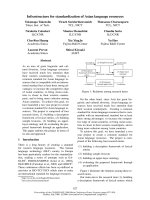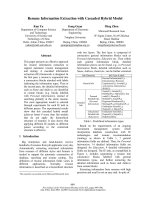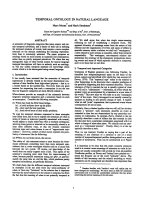Báo cáo khoa học: "building user interfaces with natural language feedback" pdf
Bạn đang xem bản rút gọn của tài liệu. Xem và tải ngay bản đầy đủ của tài liệu tại đây (236 KB, 4 trang )
WYSIWYM —
building user interfaces with natural language feedback
Roger Evans
and
Richard Power
Information Technology Research Institute
University of Brighton
1 Introduction
WYS1WYM
( 'What you see is what you meant')
is a user-interface technique which uses natural
language generation (NLG) technology to pro-
vide feedback for user interactions. To date,
the technology has been applied in a number of
demonstrator applications, using customised, non-
portable implementations. In this demonstration,
we introduce a
WYSIWYM
library package,
de-
signed to be used as a modular component of
a larger JAVA-based application. We show how
the overall design of the package aims to sup-
port a range of possible applications using sim-
ple configuration options and JAVA subclassing,
and illustrate the approach using examples ranging
from the simplest proof-of-concept application to
a complex web-delivered authoring tool for phar-
maceutical leaflets.
2
WYSIWYM —
a brief history
2.1 The
WYSIWYM
architecture
A long-standing research goal has been to enable
subject matter experts (SMEs) to create or modify
a knowledge base directly, without need for spe-
cialised training in knowledge representation lan-
guages; this is the main objective, for example, of
the Rapid Knowledge Formation project (Clark et
al., 2001). Several research groups have developed
direct-manipulation interfaces in which the current
state of the knowledge base, and the options for
editing it, are displayed diagrammatically (Skuce
and Lethbridge, 1995; Paley, 1996; Grosso et al.,
2000). The basic idea of
WYSIWYM is
to pro-
vide a direct-manipulation interface in which the
knowledge is displayed through a
feedback text,
generated automatically from the current knowl-
edge base. Options for editing are shown through
pop-up menus which open on spans of the feed-
back text. Unfilled slots in the knowledge base are
shown through coloured text spans called
anchors,
the wording of the anchor indicating the constraint
on the filler:
Swallow two tablets in this way
By clicking on the anchor
in this way,
the au-
thor obtains a list of options for filling the slot, also
presented in natural language. When an option is
selected, the system creates a filler of the specified
type, and regenerates the feedback text:
Swallow two tablets with a glass of some liquid
The revised feedback text introduces a new an-
chor, through which the author can specify that the
liquid in the glass is water. Thus by direct manip-
ulation of the feedback text, our SME author has
created a knowledge fragment equivalent to this
feature structure:
swallow
ACTOR patient
ACTEE tablet
NUMBER 2
INSTRUMENT glass
CONTENT water
However, the author need never see this struc-
ture nor understand the underlying knowledge for-
malism: all interaction with the knowledge base
is mediated through the feedback text. Additional
203
advantages of this approach are (a) that the feed-
back text can be generated in multiple languages,
thus allowing distributed editing by an interna-
tional team and automatic localisation of the inter-
face, and (b) that documentation of the knowledge
base is automatic.
2.2 Previous
WYSIWYM
implementations
Drafter
The earliest application of
WYSIWYM
developed from the
DRAFTER
project (Paris et
al., 1995), which introduced the application of
multilingual NLG for the production of instruc-
tions, using the domain of software manuals. This
project introduced the technique of
symbolic au-
thoring,
in which a SME creates a knowledge-base
from which documentation is generated in multi-
ple languages. The authoring interface was ini-
tially a conventional graphical one, but the sub-
sequent
DRAFTER-2
system (Power et al., 1998)
showed that the knowledge could be more easily
edited through direct manipulation of a text. In
DRAFTER-3
(van Deemter and Power, 1998), the
interface was extended to allow finer control over
coreference, so that given the feedback text
Remove a tablet from the foil and swallow
some-
thing
the author could copy 'a tablet', either with or
without coreference, and paste it onto the anchor
something,
obtaining two possible outcomes:
Remove a tablet from the foil and swallow it
[with coreference]
Remove a tablet from the foil and swallow an-
other tablet
[without coreference]
Of course, in either case, what was actually manip-
ulated was a fragment of knowledge, not a string
of characters, and the coreference distinction cor-
responded to whether the new reference was to the
original fragment, or a copy of it.
CLIME
In the
CLIME
project (Piwek et al.,
2000), a
WYSIWYM
interface allowed the user to
construct semantically complex queries for a legal
inference system which answered questions about
shipping regulations. This application differed
significantly from the
DRAFTER
system in a num-
ber of ways: it was not a symbolic authoring sys-
tem — the knowledge base created with
WYSIWYM
was converted into a logical formula for submis-
sion to the inference engine; it was web-delivered
— the user interface was written as a
JAVA
applet
communicating with a server-side generation en-
gine; and it added support for plurals and groups
of objects to the
WYSIWYM
expressive repertoire
(Piwek, 2000).
PILLS
The
PILLS
project (Bouayad-Agha et al.,
2002) demonstrated the application of
WYSIWYM
technology to produce documentation about phar-
maceuticals in multiple languages. From a sin-
gle 'master model' containing information about a
particular product, the program could generate in-
gredient information in three document-types (pa-
tient information leaflets, summaries of product
characteristics and European Pharmacopia entries)
and three languages (English, French and Ger-
man). The ontology and lexicons include con-
cepts extracted automatically from a large medi-
cal database, the Unified Medical Language Sys-
tem (Schultz and Hahn, 2001). As with
CLIME,
the
PILLS
interface was web-delivered, with the
output documents also being displayed via
HTML
frames.
3
The
WYSIWYM
library
In the systems just described, the
WYSIWYM
com-
ponent was tightly integrated into the applica-
tion as a whole. In order to facilitate wider and
more flexible use of
WYSIWYM
technology, we
have taken the CLIME/PILLS implementation and
repackaged it as a JAVA-based library.
The general architecture of the
WYSIWYM
li-
brary is shown in figure 1. The library has two
main components, a set of
JAVA
classes providing
the user interface and API, and a
PROLOG
subsys-
tem providing the knowledge-base management
and NLG functionality. The application devel-
oper provides the domain information (ontology
of the knowledge-base and linguistic information
for supported languages), plus configuration and
localisation information for any menu- and tool-
bars associated with the wYSIWYm panel.
There are two main aspects to configuration and
deployment of a
WYSIWYM
application. First, the
disposition of the
PROLOG
subsystem relative to
JAVA
is controlled by using different combinations
204
Domain
Ontology
WYSIWYM
engine
(prolog)
User interface
classes
(Java)
Configuration
Properties
Application
Figure 1: WYS1WYM library architecture
of the JAVA classes provided. The three principal
dispositions are internal
(PROLOG and JAVA run-
ning in a single executable),
external
(PROLOG
and JAVA as separate executables on the same sys-
tem) and
remote
(JAVA deployed as a web applet
with PROLOG running on the server).
Second, the design of the menu- and tool-bars
associated with a WYS1WYM panel, and callbacks
to the main application functions, are controlled
by simple property files, allowing a high degree of
flexible control without any additional coding or
recompilation.
In addition to these controls, the JAVA class
structure is designed to allow more sophisticated
extensions to the library, for example by subclass-
ing the options menu class to provide a more ad-
vanced concept browser.
The basic application interface to the library is
straightforward: an application creates an instance
of a w Y SIW YM interface to allow the user to create
a knowledge base. When the user has completed
the task, the knowledge base is returned to the ap-
plication as an XML string, such as
I
:
<kb>
<object id=ol name=swallow>
<role name=ACTOR target=o2/>
<role name=ACTEE target=o3/>
<role name=INSTRUMENT target=o4/>
</object>
<object id=o2 name=patient/>
<object id=o3 name=tablet>
'Notice that this encoding does not rely on the
XML struc-
ture to represent the underlying network structure, so that re-
entrancy and mutual dependence can easily be modelled.
<role name=NUMBER value=2/>
</object>
<object id=o4 name=glass>
<role name=CONTENT target=o5>
</object>
<object id=o5 name=water/>
</kb>
4 Example applications
The following example applications are included
in the library package.
4.1 A simple example
The simplest example of a w YSIWYM application
just displays a WYSIWYM window, allows the user
to construct a knowledge base within it, and then
prints out the resulting knowledge base in XML
format. This example serves primarily to show
how the components of the library fit together, and
how the configuration facilities can be used to con-
trol different aspects of the interface (components,
menus, size, language etc.).
4.2 Database interface
This example extends the simple case, by inter-
preting the knowledge base returned as a specifi-
cation of a database query to be executed. Thus
WYSIWYM
provides a natural language front-end
for a database which is completely robust — the
interface will not allow the user to construct an ill-
formed query.
4.3 The PILLS demonstrator
A more complex application of the library is a
recasting of the PILLS demonstrator, introduced
above. Here the main WYSIWYM panel is de-
ployed as a web applet in a browser, and addi-
tional functionality is provided for building WY SI-
WYM menus from file-based data (such as lists of
ingredients), displaying generated documents in a
companion browser frame, and loading and saving
WYSIWYM knowledge bases.
5 Future plans
We are continuing to develop the idea of a direct-
manipulation text-based interface in a number of
directions. The main areas of development that
may contribute to future version of the library are
as follows.
205
Coverage Provision of a core grammar includ-
ing an increased range of grammatical patterns,
for example complex tenses, sentential comple-
ments, and relative clauses. This will enhance
the system's ability to express data as text, in a
way that is largely independent of the application-
developer's interface (which would remain pri-
marily concerned with creating an ontology and
linking it to the basic linguistic resources).
Organisation of options Improvements to the
menu-based option selection, such as ordering ac-
cording to plausibility, or more advance concept-
browsing tools.
Feedback text design Since in
WYSIWYM
the
system has control over the feedback text, usabil-
ity depends on whether this text is well designed —
an issue that requires empirical testing.
Interface design Use of drag-and-drop to speed
up the operation of a coreferential copy-and-paste,
and allowing the author to maintain a palette of
icons for entities that are referenced often during
the text (e.g., the patient and the product in a pa-
tient information 1 eafl et).
References
Nadjet Bouayad-Agha, Richard Power, Donia Scott, and
Anja Belz. 2002. PILLS: Multilingual generation of
medical information documents with overlapping content.
In
Proceedings of the Third International Conference on
Language Resoures and Evaluation (LREC 2002),
pages
2111-2114, Las Palmas.
P. Clark, J. Thompson, K. Barker, B. Porter, V. Chaudhri,
A. Rodriguez, J. Thomr, Y. Gil, and P. Hayes. 2001.
Knowledge entry as the graphical assembly of compo-
nents: The shaken system. In
Proceedings of the First In-
ternational Conference on Knowledge Capture (K-CAP
Victoria, Canada.
W. Grosso, H. Eriksson, R. Fergerson, J. Gennari, S. Tu, and
M. Musen. 2000. Knowledge modeling at the millennium
— the design and evolution of protege. In
Proceedings of
the 12th International Workshop on Knowledge Acquisi-
tion, Modeling and Mangement (KAW'99),
Banff, Canada.
S. Paley. 1996. Generic knowledge-base editor user manual.
Technical report, SRI International, California.
Cecile Paris, Keith Vander Linden, Markus Fischer, Anthony
Hartley, Lyn Pemberton, Richard Power, and Donia Scott.
1995. A support tool for writing multilingual instruc-
tions. In
Proceedings of the 14th International Joint Con-
ference on Artificial Intelligence,
pages 1398-1404, Mon-
treal, Canada.
P. Piwek, R. Evans, L. Cahill, and N. Tipper. 2000. Natu-
ral language generation in the
MILE
system. In
Proceed-
ings of IMPACTS in NLG workshop,
pages 33-42, Schloss
Dagstuhl, Germany.
Implementation notes and availability
P.
The
WYSIWYM
library currently runs under Java
1.4 (j2sdk 1.4.1) and SICStus prolog 3.9.1. Most
of the basic prolog functionality is built into a
SICStus delivery image, so a SICStus licence is
not required for basic use. Ports to other pro-
log systems are also under consideration. The li-
brary will shortly be released on the ITRI website:
Piwek. 2000. A formal semantics for generating and edit-
ing plurals. In
Proceedings of COLING 2000,
pages 607—
613, Saarbruecken, Germany.
R.
Power, D. Scott, and R. Evans. 1998. What you see
is what you meant: direct knowledge editing with natu-
ral language feedback. In
Proceedings of the 13th Bien-
nial European Conference on Artificial Intelligence,
pages
675-681, Brighton, UK.
S.
Schultz and U. Hahn. 2001. Medical knowledge re-
engineering: Converting major portions of the umls into
a terminological knoweledge base.
International Journal
of Medical Informatics,
64/2-3:207-221.
Acknowledgements
The
WYS1WYM
library derives from code devel-
oped over a number of years by a number of peo-
ple in addition to the authors. Principal among
the programming credits are Chris Douce, Paul Pi-
wek and Neil Tipper, and for grammar and domain
development, Anja Belz, Nadjet Bouayad-Agha,
Lynne Cahill and Paul Piwek.
WYSIWYM
has been
developed in part through projects funded by the
EPSRC
(DRAFTER)
and the EC (CLIME, PILLS).
D. Skuce and T. Lethbridge. 1995. CODE4: A unified sys-
tem for managing conceptual knowledge.
International
Journal of Human-Computer Studies,
42:413-451.
K. van Deemter and R. Power. 1998. Coreference in knowl-
edge editing. In
Proceedings of the COLING-ACL work-
shop on the Computational Treatment of Nominals,
pages
56-60, Montreal, Canada.
206









